BMW X7 review: the large SUV you’ll either love or loathe
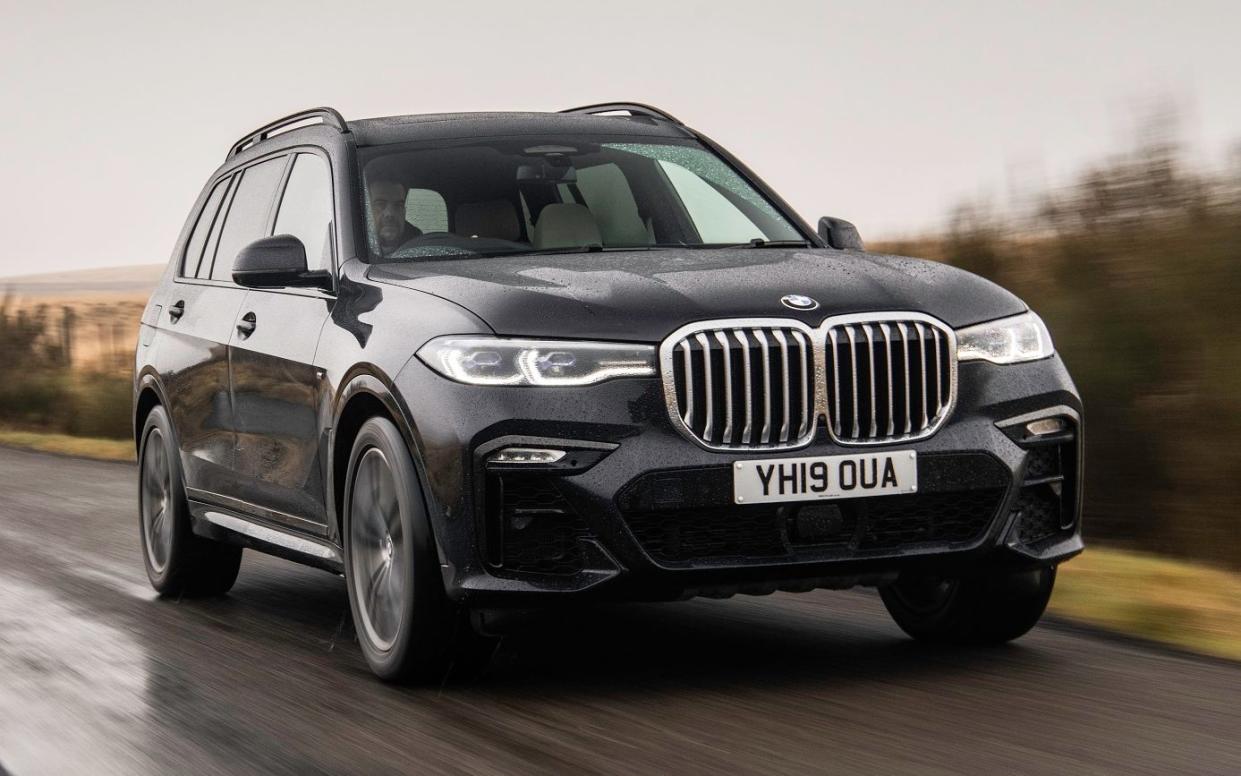
Your perception of the BMW X7 will likely rest on your reaction to its outsize grille. You might feel the X7’s nose is grand and imposing, bestowing upon this biggest of big BMW SUVs a sense of class and hauteur that sets it apart from more lowly offerings. You may, on the other hand, think it resembles nothing as much as a pair of oversized, chrome-plated rabbit incisors, and constitutes a crass and thinly-veiled effort to make the X7 look intimidating in other road users’ rear-view mirrors.
Make up your own mind. Regardless, behind that grille lurks a car for which BMW has high hopes. Until now, its largest SUV offering was the X5, a car that almost single-handedly defined the sports utility vehicle in the late 90s.
Now, though, BMW is expanding into a market hitherto dominated by larger, more luxurious SUVs like the Range Rover and Mercedes-Benz GLS. Can the BMW badge carry enough heft to succeed here? And more importantly, does the X7 have what it takes to cut it against such esteemed competition?
Pros
Incredibly smooth and quiet
Genuinely usable third row of seats (and boot)
Remarkably good fun to drive
Cons
Not cheap to buy
Sheer size makes it unwieldy
Question mark over resale values
Under the skin
You can get your X7 in two basic flavours; both are powered by 3.0-litre straight-six engines with turbos, and both get a small electric boost from a mild hybrid battery and generator. The xDrive40i is the petrol model, with 328bhp, while the diesel xDrive 40d we’re testing here has 335bhp.
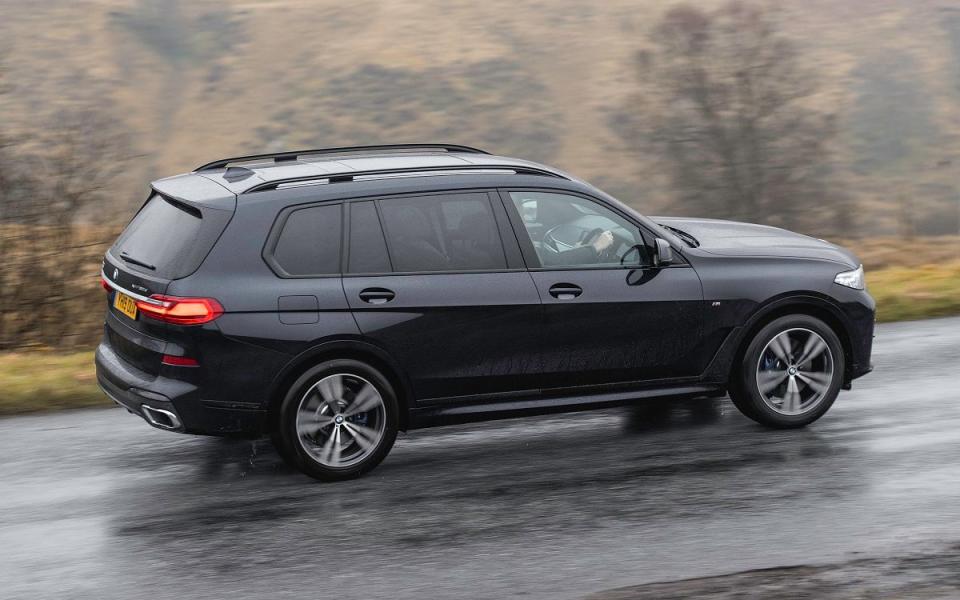
Our test car also came in the more popular M Sport variant; frankly, we wouldn’t bother upgrading given the standard car is already dripping with kit, and all your extra cash buys you is a body kit which serves to make the X7 look even more belligerent, along with a smattering of extra design tweaks around the car.
If you really are feeling flush, though, there’s always the M50i, whose 4.4-litre V8 can boast 523bhp, allowing this leviathan to hit 62mph from a standstill in just 4.7 seconds – which just goes to show that they still scoff at the laws of physics over in Bavaria. Having said that, its 23mpg fuel consumption is a reminder that said laws can never be fully evaded.
Interior space
It’s something of an understatement to say this is a big car; in fact, it’s about the size of the Mercedes-Benz GLS it counts as its chief rival, and larger than the Range Rover Sport, Volvo XC90 and Audi Q7 it also goes up against.

All of those competitors, with the exception of the Range Rover, come with seven seats as standard and so it goes with the X7. Its rearmost row is one of the most spacious of its kind, too; in fact, slide the middle row forward sufficiently to create enough leg room for two adults to sit in the third row, and you’re still left with enough room to seat three abreast in the second.
Even with all seven seats in position there’s a reasonable amount of boot space, with a large under-floor locker that extends beneath the last row and allows you to stash bags away unseen.
Start folding away seats and the amount of space on offer just grows; cleverly, you can push and hold one of two ‘Max’ buttons just inside the split tailgate, which electronically folds all the seats down at once, while the other returns them to their positions in the same way – extremely handy to save you having to go round and fold all of them individually.
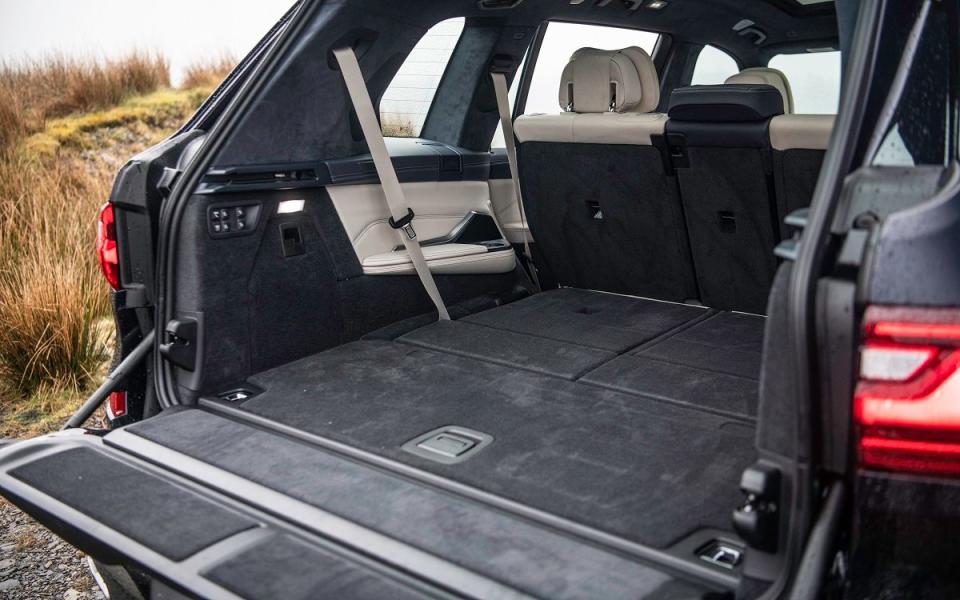
And when all the seats are down, you’re left with a flat and very useful load area; in two-seat mode, the X7 effectively becomes a large van, though given the space is lined with expensive-feeling leather, you probably won’t want to transport anything too grimy.
In the two front seats, it comes as no surprise to find that there’s an excess of space on offer; from here, the X7 feels airy and bright, its big, tall windows and imperious driving position offering impressive visibility and making it surprisingly easy to position on the road.
The dashboard is pretty similar in design to most other modern BMWs, though that’s no bad thing, as you get plush materials and a big, crisp and clear widescreen entertainment system that you can control either through touch or by using the big rotary controller down by your left hip – the best of both worlds.

Further good sense comes with the climate controls; BMW has resisted the current fad of turning these into a touchscreen, and as a result they work well and are easy to use on the move. In fact, the only slightly bum note is BMW’s virtual dial display, whose busy design isn’t all that easy to read at a glance.
Big money
All this sounds good so far, but it probably won’t have escaped your attention that the X7 doesn’t come cheap. In fact, it’s costlier to buy than both the equivalent Mercedes-Benz GLS and Range Rover Sport. The equivalent Audi Q7 and Volvo XC90 will both cost you even less, too, although neither offers as much space nor as much power.
Things look slightly better if you’re planning to pay on finance, though, with the X7 looking cheaper than the GLS and roughly on a par with the Range Rover Sport – though it’ll still set you back more than either of the slightly smaller cars.
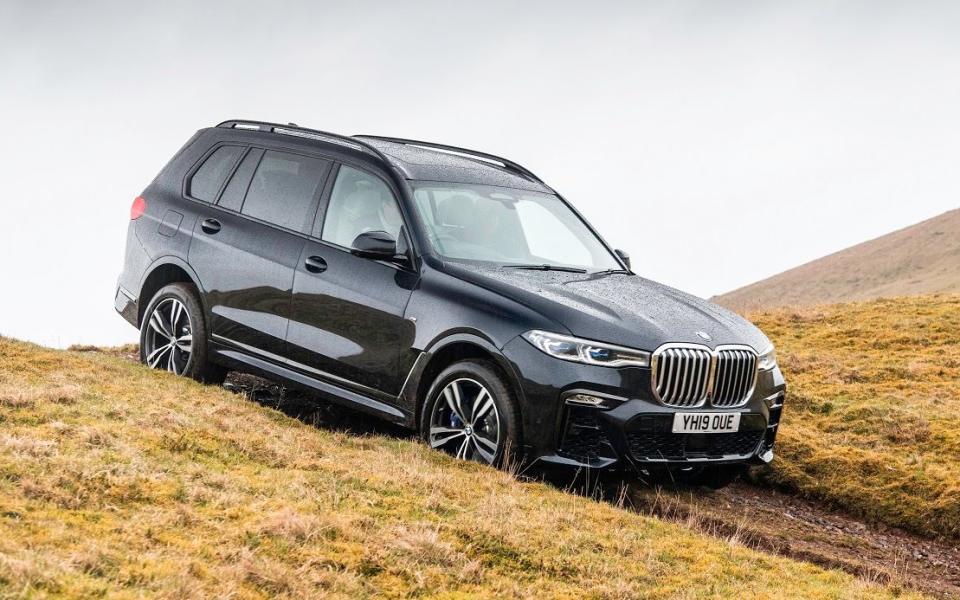
That would suggest that the X7 will hold its value pretty well, but some of our other sources for residuals reckon it’ll actually cost you more in depreciation than any other rival. In short, the jury’s out on that front.
Either way, the BMW plays well on fuel economy; it’s surprisingly frugal for a car of its size and power, and with relatively low CO2 emissions it should make for a relatively affordable company car – though of course, it can’t compete on this front with plug-in hybrids from Land Rover and Volvo, or indeed, BMW’s own X5 xDrive45e.
Wide load
The moment you have to negotiate a tight turn in the X7, you’re immediately aware of its girth. There isn’t that much steering lock, so exiting on to a narrow road or turning into an acutely-angled junction sometimes requires both lanes, as though you’re driving a truck.

This lack of manoeuvrability isn’t unique among cars of this size, but it is worth bearing in mind if you plan to use the X7 in town regularly; squeezing down narrow streets with high walls imperils your mirrors, while tight multi-stories become a mass of concrete stanchions all primed to scrape their way down your car’s pristine flanks if you misjudge by mere millimetres. And when you do actually park, the X7 fills most normal car parking spaces so completely that there’s little space left to open the doors and climb out.
If it feels out of place in town, the X7 feels entirely at home on the motorway. Here, the air suspension smoothes out bumps almost perfectly, leaving only the faintest suggestion of a ripple over sharper creases and expansion gaps. And while the roar of the big 22-inch tyres of our test car was noticeable, if not invasive, wind noise is remarkably well controlled for such a big, bluff car.
The same can be said for engine noise, in fact; at a cruise, there’s the faintest suggestion of a murmur from the big straight six, but little more. Call for more power and the gearbox changes down quickly and without fuss, the engine note taking on a rather satisfying growl as it does so.
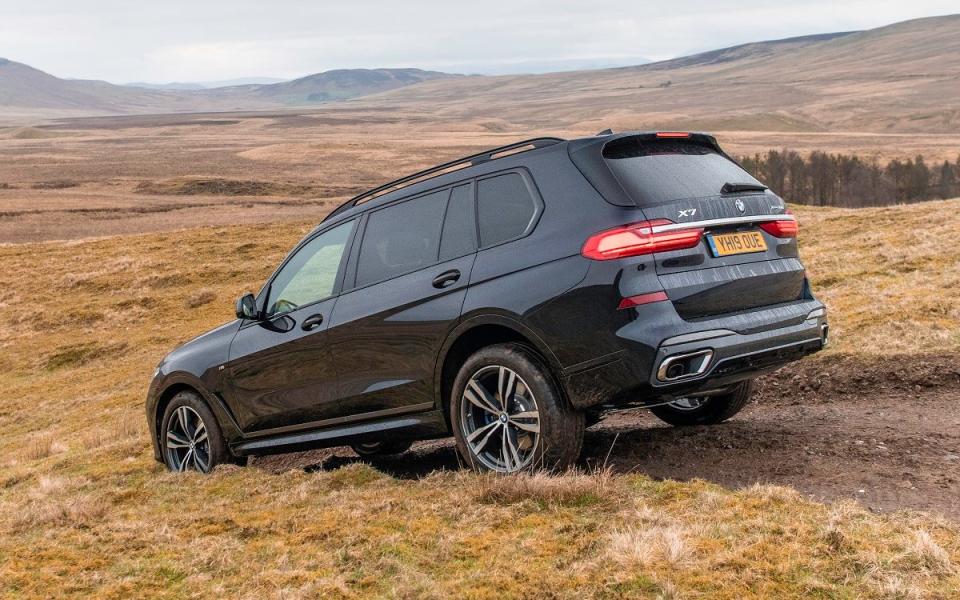
The X7 doesn’t feel like a fast car from the driver’s seat – blame the layers of sound deadening and the lofty driving position – but a look at the figures suggests it isn’t exactly slow. Indeed, when you prod the throttle a bit harder it delivers the sort of solid, unrelenting swell of shove you get with a big, gutsy engine that’s been set up well. Overtakes are accomplished with barely a moment’s thought, and the motorway slip road sprint has you up to the national speed limit in no time at all. Yes, ‘exciting’ is probably the wrong word for it, but ‘satisfying’ feels more appropriate.
Off the motorway
That the X7 proves just as satisfying away from the motorway comes as more of a surprise. BMW has done a remarkably good job of making a two-tonne, seven-seat SUV feel almost as sprightly as a 5-Series Touring when you throw it around a bit.
Sure, if you yank the steering wheel and prod the throttle hard, all that mass tries to push on ahead before the electronics cut in and sort everything out.

But drive just a touch more sympathetically and the quick, responsive steering and crisp, accurate turn-in make the X7 feel much smaller and lighter than it is. And while there’s just enough movement in the body to give you a good idea of the car’s pitch, which helps involve you in the process, the suspension stops the body lurching or leaning, allowing you to make use of the big tyres’ grip, and to pick the perfect time to take advantage of the X7’s inherent traction to fire yourself out of the bend using all of that muscular torque.
In fact, all that really stops you truly cutting loose is the nagging from the lane departure warning system, which vibrates the steering wheel all too often, because despite the fact your nearside mirror is in the hedge, your offside wheels are straying over the road’s dividing lines – a constant reminder that as good as the X7 is on roads like these, there’s no getting around its sheer size.
The Telegraph verdict
Should we hold that against it? It’s easy to deride it as a gluttonous lump of hedonism, a paean to consumerist consumption in a world in which curbing such excesses for the sake of future generations seems to be ever more prudent.
On the other hand, manufacturers wouldn’t make cars like these if they couldn’t sell them, and in the context of the market in which it competes the X7 is pretty impressive; every bit as good to drive as any of its rivals despite being roomier than any of them and just as comfortable, if not more so. In this form, it’s even tolerably fuel efficient, too.
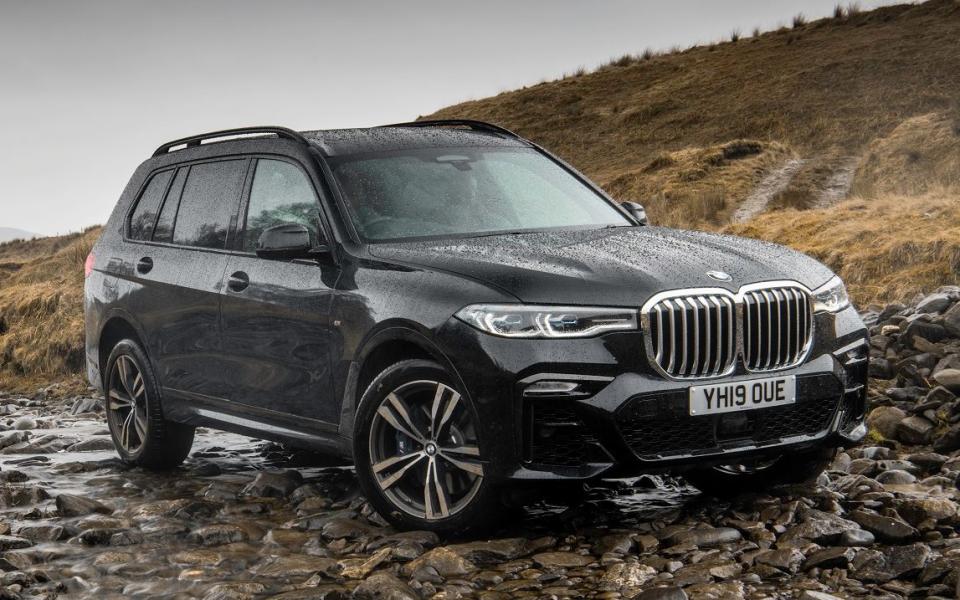
Even in that context, though, it’s expensive to buy, a bitter pill that’s made slightly easier to swallow by competitive finance deals – which is surely the way most of these cars will find homes, if not as company cars, in which role the X7 also makes some sense.
So if you are in need of a gigantic seven-seater with luxury in spades and you aren’t planning to buy it outright, the X7 deserves your attention. Just try not to focus said attention for too long on the grille.
Telegraph rating: Four stars out of five
The facts
On test: BMW X7 xDrive40d M Sport
How much? £80,170 on the road
How fast? 152mph, 0-62mph in 6.1sec
How economical? 36.2mpg (WLTP Combined)
Engine/gearbox: 2,993cc six-cylinder diesel with 335bhp, eight-speed automatic gearbox, four-wheel drive
The electric bits: 48-volt mild hybrid system with starter-generator and dedicated battery
Electric range: 0 miles
CO2 emissions: 204g/km
VED: £1,345 first year, £490/year for five years thereafter, then £155/year
Warranty: 3 years / unlimited miles
Boot size: 300 litres
Spare wheel as standard: No (not available)
The rivals
Mercedes-Benz GLS 400d AMG Line Premium
325bhp, 30.7mpg, £79,480 on the road
Probably the X7’s arch-nemesis, the GLS is of similar stature and just as comfortable and almost as roomy, but it can’t hide its weight anywhere nearly as well on a back road, and while it is cheaper to buy than the BMW, it’s quite a bit thirstier too.
Range Rover Sport D300 HSE Dynamic
296bhp, 30.7mpg, £75,280 on the road
The Range Rover Sport has always been the big SUV of choice for those who like to get a lick on, but now that crown has been challenged by the X7, which is a little sharper, a bit more spacious, a touch more powerful and noticeably more economical. There’s also the small matter of Land Rover’s poor reliability record to throw into the mix.
Volvo XC90 B6P R Design Pro
296bhp, 30.7mpg, £69,070 on the road
With a gutsy mild hybrid petrol engine that gets diesel-like economy, a considerably lower price and a similarly creamy-smooth ride quality, this XC90 is a tempting alternative to the X7; It’s a smaller car, too, so it’s less of a handful around town, though the payoff is that it doesn’t feel quite as spacious in the back.
For new and used buying guides, tips and expert advice, visit our Advice section, or sign up to our newsletter here
To talk all things motoring with the Telegraph Cars team join the Telegraph Motoring Club Facebook group here

 Yahoo News
Yahoo News 
